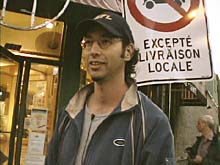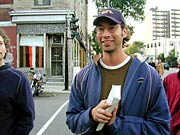

Nicholas Amberg a participé à plusieurs expositions de groupe et a exposé durant le Mois de la Photo à Montréal (1993). Il a publié dans la revue CV photo no 23 un portefolio extrait d'une série intitulée Atemporal ground constituée "de visages captés comme des paysages". ll détient un Baccalauréat en arts visuels, photographie de l’Université Concordia. Il s'interroge dans son travail sur le paradoxe de l'utilisation de procédés traditionnels pour produire des images contemporaines. L'univers qu'il observe est celui de son environnement intime; ses amis, les lieux de son enfance et ceux qu'il habite et visite aujourd'hui.
Rachelle-Béry
4660, boul. Saint-Laurent
On pourra choisir une carte postale parmi cette série arborant différentes scènes de vie et de voyages, la ramener chez soi, s’en inspi-rer durant quelques jours, puis y noter un commentaire ou les bribes d’une histoire à partager avec autrui. Car c’est autour du processus de correspondance et du partage des idées que gravite Postcards, une intervention mouvante axée sur le désir de communiquer. En recueillant les mots des passants ou des résidents de Villeneuve, l’œuvre rend compte de la présence de l’autre. Elle s’imprègne d’une mémoire collective.
Extrait du texte
Villeneuve revisité
de Sylvette Babin


Nicholas Amberg lives and works in Montreal. He has been part of the Fovea photography collective since 1993 participating in numerous group exhibitions over that period. Holding degrees in both Fine Arts and English Literature, his work often combines the photographic process with prose, and concerns what he refers to as his "immediate environment". He teaches photography at the Saidye Bronfman Center for the Arts and graphic design and multimedia at the Academy of Design.
POSTCARD
One could choose a postcard from this series that displays different scenes of life and travel. One could take them home, let oneself be inspired for several days, and then add a commentary or fragments of a story to share with others. As a moving intervention based on the desire to communicate, Postcards gravitates around the process of correspondence and sharing of ideas. In gathering the words of passersby or Villeneuve residents, the work acknowledges the presence of the other. It absorbs and carries a collective memory.
Excerpt from
Villeneuve revisited
by Sylvette Babin
Translation by
Bernard Schutze
STATEMENT
For me this notion of bringing art to a public space is an attempt to parallel the artist-viewer-gallery connection into a broader organic relationship.
In this case the "art" on display will be stamped addressed post cards. The "gallery" will be the Rachel-Berry health food store, and the viewership will be the store's patrons. Hopefully, the post cards, carrying images of landscape, travel, food etc. (my photographic interests/essence and therefor life essence), will be interesting enough to elicit a written response from those patrons who wish to take a post card home with them, write a response, and mail it back to the store - the post cards act as a comment book does in a traditional gallery. With more time and thought, however, rather than writing "nice photo" or "wouldn't hang this on my wall", the viewer might in fact take the time to write a thoughtful response, comment, poem, inspiration, concern, peeve, criticism, scratch, or even, maybe, a recipe -let's hope. The post cards will be mailed back to the store so that the viewers/patrons can read new cards as they come in and get an interesting cross section of comments/slice-of-life - .i.e. public involvement.
This seems like an interesting way to involve the public in the process of creating. In the end, what remains, although perhaps neither profound nor resonant, is surely a document of a creative process that should prove to be illuminating.
Nicholas Amberg